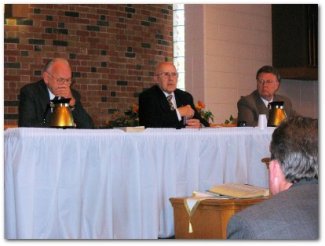Resolutions on Fundamentalism, Part 2
 The ACCC adopted four resolutions on fundamentalism at this year’s conference. The Resolution on Instances of Abuse wihin Professed Fundamentalism posted here earlier this week. Two of the remaining resolutions appear below.
The ACCC adopted four resolutions on fundamentalism at this year’s conference. The Resolution on Instances of Abuse wihin Professed Fundamentalism posted here earlier this week. Two of the remaining resolutions appear below.
Resolution on Cherishing the Heritage of Biblical Fundamentalism
Resolution 11-01
When exhorting his readers to patient endurance of the race set before them, the author of Hebrews affirms the importance both of looking ahead and of looking back. Looking ahead the believer must depend upon the person and work of Jesus Christ, the Author and the Finisher of our faith, and looking back he must draw encouragement and inspiration from a cloud of witnesses that once preceded and now encompasses him (Heb. 12:1-2).
The faithful men and women of Hebrews 11 comprise this cloud of witnesses: Abel, Enoch, Noah, Abraham and the patriarchs, Moses, Rahab, and others. Time would not allow the author to go on listing all the names (v. 32), so he summarizes their character by referring to their accomplishments (vv. 33-39). They were fallible servants of the Lord, but that is not the focus of this passage. Instead, an abundance of past-tense verbs expresses the affluence of the author’s appreciation for these true heroes of the faith.
This appreciation for the past enjoins us in the present to a similar faithfulness, for the author explains that, apart from us, the work of predecessors cannot be perfected (v. 40). We follow in their train. In addition, the appreciation for the past expressed in Hebrews extends not only to distant Biblical history, but also to more immediate examples, the pattern of those who spoke the Word to us (13:7-8). We are to remember with thankfulness their leadership, value the results of their ministry, and imitate their faith. Cherishing the heritage they provided for us reflects the immutable character of the Lord we serve, Jesus Christ, who is the same yesterday, today, and forever, and it safeguards against the temptations of varied and strange teachings (vv. 8-9).
 Resolution on the Convention Theme—Taking Heed
Resolution on the Convention Theme—Taking Heed NOTE: This article was orginally published on November 3, 2005. It was part of a liveblog of the 2005 Annual Convention of the
NOTE: This article was orginally published on November 3, 2005. It was part of a liveblog of the 2005 Annual Convention of the 
Discussion